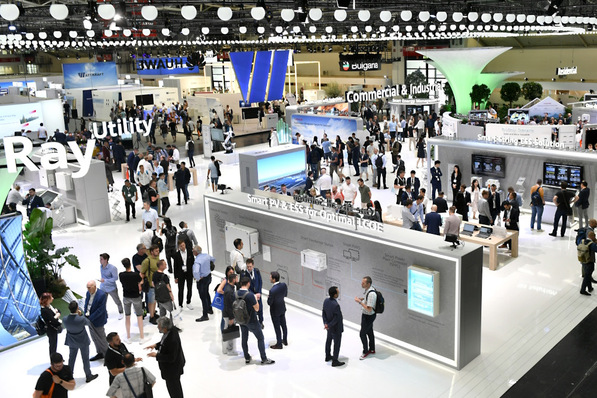Local projects examining the potential of this technology are currently underway in more than a third of all nations around the globe, and estimates suggest there are around 400 plants already in operation in more than 40 countries, with a total capacity of more than 3 gigawatts (GW). Over the next four years, experts predict that floating PV capacity will see an annual increase of more than 20 percent worldwide, with two thirds of this growth expected in markets such as China, India, Indonesia, South Korea, Taiwan, Thailand and Vietnam.
Particularly in Asia, floating photovoltaic plants are getting ever larger. At the end of 2021, China installed a 320 megawatt (MW) floating PV plant on one of the country’s reservoirs. And in Indonesia, a 145 MW floating solar power plant on the Cirata reservoir is due to start commercial operations in the fourth quarter of 2022.
Did you miss that? Offshore floating PV: Sun meets the sea
Over the last five years, Europe too has seen a growing trend towards floating PV plants – a development that is hardly surprising given the enormous potential of this technology. According to Dutch researchers, there is the potential to generate 25 GW of capacity using inland waters and 45 GW out at sea. Moreover, the Fraunhofer Institute for Solar Energy Systems (ISE) in Freiburg, Germany, has calculated that the artificial lakes at former brown coal mines in Germany alone have the technical potential to host up to 56 GW of floating PV.
Nonetheless, despite all the potential, Germany and others have been slow to embrace this technology. This is partly due to a lack of empirical data, but mostly due to the specific conditions that must be met – in terms of design, materials, system components, operation and environmental impact – when working with bodies of water. Long-term environmental sustainability, in particular, is a vital requirement that floating PV plants must fulfill if they are going to be approved for use in many European markets.
Floating photovoltaic plants as an increasingly attractive and politically accepted solution
Floating PV might still be something of a niche area in Europe, but European industry is expected to devote significantly more time and energy to this technology in future. The key reason for this is that floating PV helps resolve the land usage conflict with the agricultural sector, which sees large ground mounted PV plants as a growing threat to its already dwindling stock of agricultural land. It is also worth pointing out that the layout of floating PV plants means they can generate more megawatts per hectare than their ground-mounted counterparts. The Netherlands, for instance, have decided to launch an initial project, which aims to make more efficient use of the space between the road lanes at a highway junction. Moreover, depending on the location of the plant, the natural cooling effect of the water can give floating PV plants an extra performance boost – by a few percentage points – making them a more cost-effective solution. And that’s not all: By helping to reduce water evaporation, these floating plants play yet another vital role in protecting our planet – one that is all the more important in the face of accelerating climate change.
Did you miss that? Germany: First subsidy-free floating PV plant
In terms of business models, we’re currently seeing two main trends. Firstly, there are projects using conventional still water bodies such as quarry lakes. In this case, the power generated by the plants is used directly to transport the gravel and process it locally. Secondly, we are seeing the growing use of reservoirs. At times of year when the water level is low and reservoirs can only produce a limited amount of electricity, floating PV plants can help top up the supply. Moreover, this split system means floating PV plants can be installed using the existing electrical infrastructure, which helps keep investment costs down. This makes them a more attractive investment option, e.g. for financing through power purchase agreements (PPAs) over multiple years. Another interesting option, especially for municipalities, is to install floating PV systems at wastewater treatment plants, either on the sedimentation tanks or on the reservoirs for the treated water. A number of pilot projects of this kind are already underway, including in California and South Africa.
To give its market for floating PV plants a boost, in April 2022 Germany is launching a series of innovation tenders in line with plans set out in its Renewable Energy Act (EEG). In total, the tenders aim to generate 150 MW. Eligible plants must have up to 2 MW capacity. In its coalition agreement, Germany’s new federal government also confirmed that it plans to promote greater use of floating PV. In December 2021, preparations began for a floating PV plant on the Cottbuser Ostsee, an artificial lake created at the site of a former brown coal mine. With a capacity of 21 MW, the plant will be the largest floating PV plant in Germany.
Floating PV “Made in Europe”
Companies and national research bodies across Europe are increasingly turning their attention to the possibilities of floating PV. To date almost all projects have focused on inland waters. To address the lack of concrete project experience and kick start the relatively slow development of this technology, several EU projects, including FRESHER and DESTINY, have now been launched. Running in parallel to these are a number of industry cluster projects, including the Marine Floating Solar Technology Innovation Project in Belgium and the Joint Industry Project run by DNV, which led to the publication of a 150-page set of guidelines. Summer 2021 also saw the launch of PV2Float, a three-year German research project supported by the Fraunhofer Institute for Solar Energy Systems (ISE), German energy company RWE AG and the Brandenburg University of Technology Cottbus-Senftenberg. Alongside these projects, work is also ongoing to achieve the necessary standardization within the sector.
Maritime/offshore floating PV headed for new shores
European efforts to promote floating PV are not limited to still water bodies. A number of companies, particularly those in the Netherlands and Norway that have decades of experience in the offshore sector, are launching the first pilot projects to test floating PV systems on the open sea. In line with this work, researchers at Utrecht University have also used computer modeling to calculate that solar modules installed at sea generate, on average, 13% more power than ground-mounted PV plants on land. The Flemish Blue Cluster organization is also supporting a pilot project looking at one way offshore PV plants could be used in future – namely the possibility of combining offshore solar plants with offshore windfarms. The idea is to install the floating PV plants in the gaps between the existing wind power sites as well as using their grid infrastructure. This approach makes more efficient use of the available space and also proportionately increases the amount of power generated.
Floating PV at Intersolar Europe and its accompanying conference
This year’s Intersolar Europe will be held from May 11 to 13, as part of The smarter E Europe 2022 at Messe München. The event and the accompanying Intersolar Europe Conference, both of which are major sources of inspiration for the solar industry, will be helping shine a spotlight on the exciting area of floating PV. The Intersolar Europe Conference is taking place on May 10 and 11, 2022, at Internationales Congress Center München. (hcn)
Intersolar Europe Conference – Next Generation Space Efficient Solar:
• May 11, 2022, from 9:00am to 3:30pm, in room 14 C: Floating Solar – Advantages of Solar on Water
• May 10, 2022, from 2:30pm to 6:00pm, in room 12: Agri-PV – Multiplying Benefits with Solar on Agricultural Land
• May 10, 2022, from 11:30am to 1:00pm, in room 12: BIPV – Getting Ready For Embracing Solar As a Building Material
For more information, please visit:







